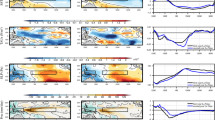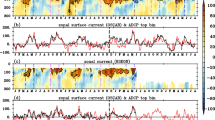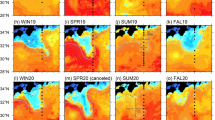Abstract
Meso-scale eddies are important features in the South China Sea (SCS). The eddies with diameters of 50–200 km can greatly impact the transport of heat, momentum, and tracers. A high-resolution wave-tide-circulation coupled model was developed to simulate the meso-scale eddy in the SCS in this study. The aim of this study is to examine the model ability to simulate the meso-scale eddy in the SCS without data assimilations The simulated Sea Surface Height (SSH) anomalies agree with the observed the AVISO SSH anomalies well. The simulated subsurface temperature profiles agree with the CTD observation data from the ROSE (Responses of Marine Hazards to climate change in the Western Pacific) project. The simulated upper-ocean currents also agree with the main circulation based on observations. A warm eddy is identified in winter in the northern SCS. The position and domain of the simulated eddy are confirmed by the observed sea surface height data from the AVISO. The result shows that the model has the ability to simulate the meso-scale eddy in the SCS without data assimilation. The three-dimensional structure of the meso-scale eddy in the SCS is analyzed using the model result. It is found that the eddy center is tilted vertically, which agrees with the observation. It is also found that the velocity center of the eddy does not coincide with the temperature center of the eddy. The result shows that the model has the ability to simulate the meso-scale eddy in the SCS without data assimilations. Further study on the forming mechanism and the three-dimensional structure of the meso-scale eddies will be carried out using the model result and cruise observation data in the near future.
Similar content being viewed by others
References
Cheng Li, Zhang Zhiwei, Zhao Wei, et al. 2015. Temporal variability of the current in the northeastern South China Sea revealed by 2.5-year-long moored observations. J Oceanogr, 71(4): 361–372
Chu P C, Edmons N L, Fan Chenwu. 1999. Dynamical mechanisms for the South China Sea seasonal circulation and thermohaline variabilities. Journal of Physical Oceanography, 29(11): 2971–2989
Da Silva A M, Young C C, Levitus S. 1994. Atlas of Surface Marine Data 1994. vol. 1, Algorithms and Procedures. NOAA Atlas NESDIS 6, US Dept of Comm., Washington, D C
Dale W L. 1956. Wind and drift currents in the South China Sea. The Malaysian Journal of Tropical Geography, 8: 1–31
Ducet N, Le Traon P Y, Reverdin G. 2000. Global high resolution mapping of ocean circulation from TOPEX/Poseidon and ERS- 1/2. J Geophys Res, 105(C8): 19477–19498
Egbert G D, Bennett A F, Foreman M G G. 1994. TOPEX/POSEIDON tides estimated using a global inverse model. J Geophys Res, 99(C12): 24821–24852
Ezer T, Arango H, Shchepetkin A F. 2002 Developments in terrain following ocean models: Intercomparisons of numerical aspects, Ocean Modelling, 4: 249–267
Fang Guohong, Dwi Suanto, Sugiarta Wirasantosa, et al. 2010. Volume, heat and freshwater transports from the South China Sea to Indonesian Seas in the boreal winter of 2007–2008. Journal of Geophysical Research, 115(C12): doi: 10.1029/2010JC006225
Fang Guohong, Fang Wendong, Fang Yue, et al. 1998. A survey of studies on the South China Sea upper ocean circulation. Acta Oceanographica Taiwanica, 37(1): 1–6
Fang Wendong, Fang Guohong, Shi Ping, et al. 2002. Seasonal structures of upper layer circulation in the southern South China Sea from in situ observations. Journal of Geophysical Research, 107(C11): doi: 10.1029/2002JC001343
He Yinghui, Cai Shuqun, Wang Dongxiao, et al. 2015. A model study of Luzon cold eddies in the northern South China Sea. Deep-Sea Research Part I: Oceanographic Research Papers, 97: 107–123
Hu Jianyu, Kawamura H, Hong Huasheng, et al. 2000. A review on the currents in the South China Sea: Seasonal circulation, South China Sea warm current and Kuroshio Intrusion. Journal of Oceanography, 56(6): 607–624
Levitus S. 1982. Climatological atlas of the world ocean. NOAA Prof Paper No 13. US Govt Printing Office, 173
Li Li, Wu Risheng, Guo Xiaogang. 2000. Seasonal circulation in the South China Sea: A TOPEX/Poseidon satellite altimetry study. Haiyang Xuebao (in Chinese), 22(6): 13–26
Lin Xiayan, Dong Changming, Chen Dake, et al. 2015. Three-dimensional properties of mesoscale eddies in the South China Sea based on eddy-resolving model output. Deep-Sea Research Part I: Oceanographic Research Papers, 99: 46–64
Mellor G L, Oey L Y, Ezer T. 1998. Sigma coordinate pressure gradient errors and the seamount problem. J Atmos Oceanic Technol, 15(5): 1122–1131
Mellor G L, Ezer T, Oey L Y. 1994. On the pressure gradient conundrum of sigma-cordinate ocean models. J Atmos Oceanic Technol, 11(4): 1120–1129
Mellor G L, Yamada T. 1982. Development of a turbulence closure model for geophysical fluid problems. Rev Geophys, 20(4): 851–875
Qiao Fangli, Chen Shunnan, Li Chengxi, et al. 1999. The study of wind, wave, current extreme parameters and climatic characters of the South China Sea. Journal of Marine Technology, 33(1): 61–68
Qiao Fangli, Yang Yongzeng, Xia Changshui, et al. 2008. The role of surface waves in the ocean mixed layer. Acta Oceanologica Sinica, 27(3): 30–37
Qiao Fangli, Yuan Yeli, Yang Yongzeng, et al. 2004. Wave-induced mixing in the upper ocean: Distribution and application to a global ocean circulation model. Geophys Res Lett, 31(11): doi: 10.1029/2004GL019824
Qiu Bo, Chen Shuiming. 2005. Eddy-induced heat transport in the subtropical North Pacific from Argo, TMI, and altimetry measurements. Journal of Physical Oceanography, 35(4): 458–473
Roemmich D, Gilson J. 2001. Eddy transport of heat and thermocline waters in the North Pacific: A key to interannual/decadal climate variability?. Journal of Physical Oceanography, 31(3): 675–687
Shan Feng, Qiao Fangli, Lv Xingang, et al. 2009a. A numerical study of the wintertime double-warm-tongue structure in the Huanghai (Yellow) Sea. Acta Oceanologica Sinica, 28(4): 8–15
Shan Feng, Qiao Fangli, Xia Changshui. 2009b. numerical study of summertime expansion pattern of Changjiang (Yangtze) River diluted water. Acta Oceanologica Sinica, 28(3): 11–16
Shaw P T, Chao S Y. 1994. Surface circulation in the South China Sea. Deep-Sea Res I, 41(11–12): 1663–1683
Wang Dongxiao, Liu Yun, Qi Yiquan, et al. 2001. Seasonal variability of thermal fronts in the northern South China Sea from satellite data. Geophys Res Lett, 28(30): 3963–3966
Wang Lei, Gan Jianping. 2014. Delving into three-dimensional structure of the West Luzon Eddy in a regional ocean model. Deep-Sea Research Part I: Oceanographic Research Papers, 90: 48–61
Wang Qiang, Zeng Lili, Zhou Weidong, et al. 2015. Mesoscale eddies cases study at Xisha waters in the South China Sea in 2009/2010. J Geophys Res Oceans, 120(1): 517–532
Wyrtki K. 1961. Scientific results of marine investigations of the South China Sea and the Gulf of Thailand 1959–1961. Naga Report, 2: 164–169
Xia Changshui, Qiao Fangli, Yang Yongzeng, et al. 2006. Three-dimensional structure of the summertime circulation in the Yellow Sea from a wave-tide-circulation coupled model. Journal of Geophysical Research, 111(C11): doi: 10.1029/2005JC003218
Yang Haijun, Liu Qinyu, Liu Zhengyu, et al. 2002. A general circulation model study of the dynamics of the upper ocean circulation of the South China Sea. Journal of Geophysical Research, 107(C7): 22-1–14
Yang Yongzeng, Qiao Fangli, Zhao Wei, et al. 2005. MASNUM ocean wave model in sphereical coordinate and its application. Acta Oceanologica Sinica, 27(2): 1–7
Yuan Yeli, Hua Feng, Pan Zengdi, et al. 1991. LAGDF-WAM numerical wave model. Acta Oceanologica Sinica, 10(4): 483–488
Yu Weidong, Qiao Fangli, Yuan Yeli, et al. 1997. Numerical modeling of wind and waves for Typhoon Betty (8710). Acta Oceanologica Sinica, 16(4): 459–473
Yu Yongqiang, Liu Hailong, Lin Pengfei. 2012. A quasi-global 1/10° eddy-resolving ocean general circulation model and its preliminary results. Chinese Science Bulletin 57(30): 3908–3916
Zhang Zhiwei, Zhao Wei, Tian Jiwei, et al. 2013. A mesoscale eddy pair southwest of Taiwan and its influence on deep circulation. J Geophys Res Oceans, 118(12): 6479–6494
Zhao Chang, Wang Gang, Qiao Fangli, et al. 2015. A numerical investigation into the long-term behaviors of Fukushima-derived 137Cs in the ocean. Acta Oceanologica Sinica, 34(12): 37–43
Zu Tingting, Gan Jianping, Erofeeva S Y. 2008. Numerical study of the tide and tidal dynamics in the South China Sea. Deep-Sea Research Part I: Oceanographic Research Papers, 55(2): 137–154
Author information
Authors and Affiliations
Corresponding author
Additional information
Foundation item: The National Basic Research Program (973 Program) of China under contract No. 2014CB745004; China-Korea Cooperation Project on the development of oceanic monitoring and prediction system on nuclear safety; the National Natural Science Foundation of China under contract No. 41206025; NSFC—Shandong Joint Fund for Marine Science Research Centers under contract No. U1406404. The research was partially supported by China-Korea Joint Ocean Research Center.
Rights and permissions
About this article
Cite this article
Xia, C., Jung, K., Wang, G. et al. Case study on the three-dimensional structure of meso-scale eddy in the South China Sea based on a high-resolution model. Acta Oceanol. Sin. 35, 29–38 (2016). https://doi.org/10.1007/s13131-016-0805-1
Received:
Accepted:
Published:
Issue Date:
DOI: https://doi.org/10.1007/s13131-016-0805-1




